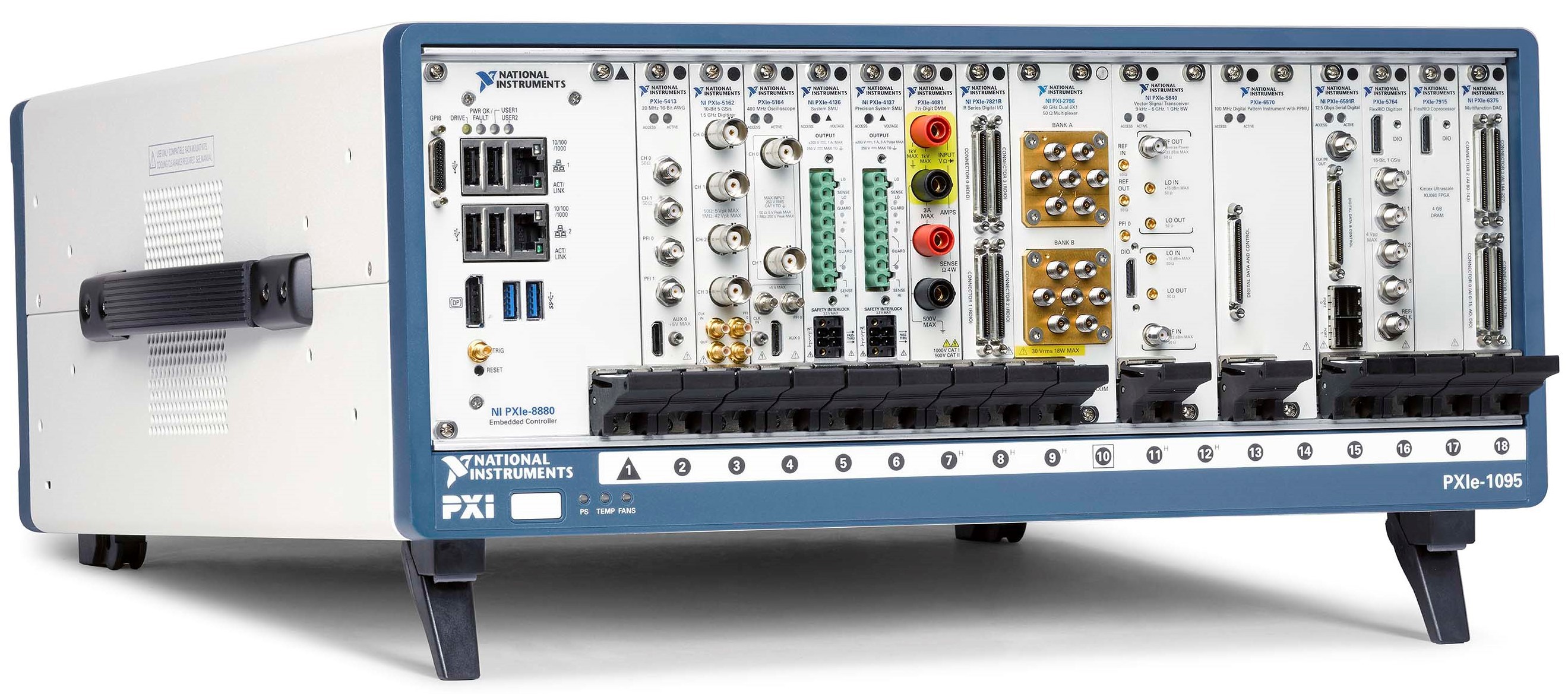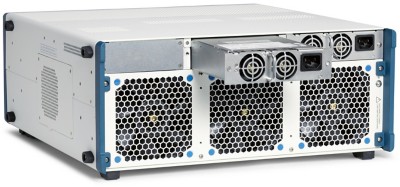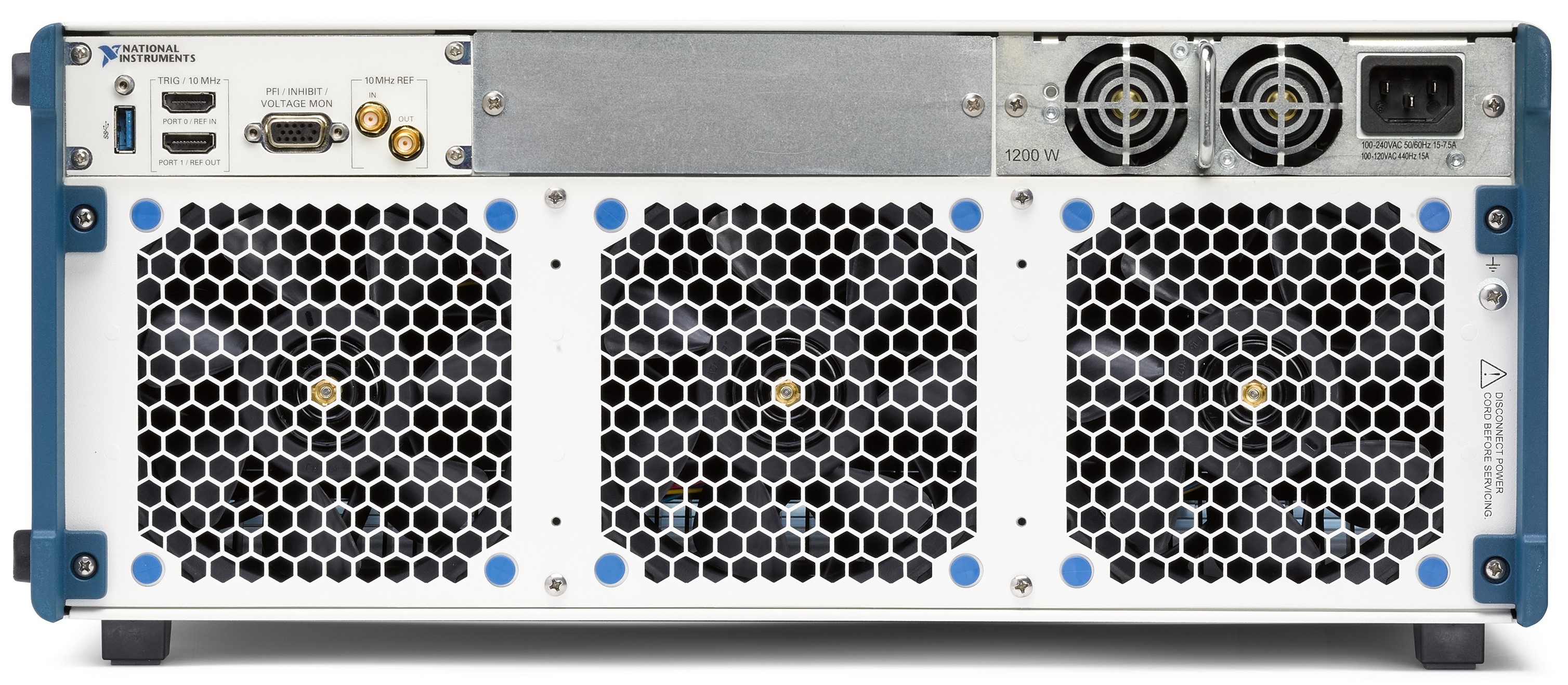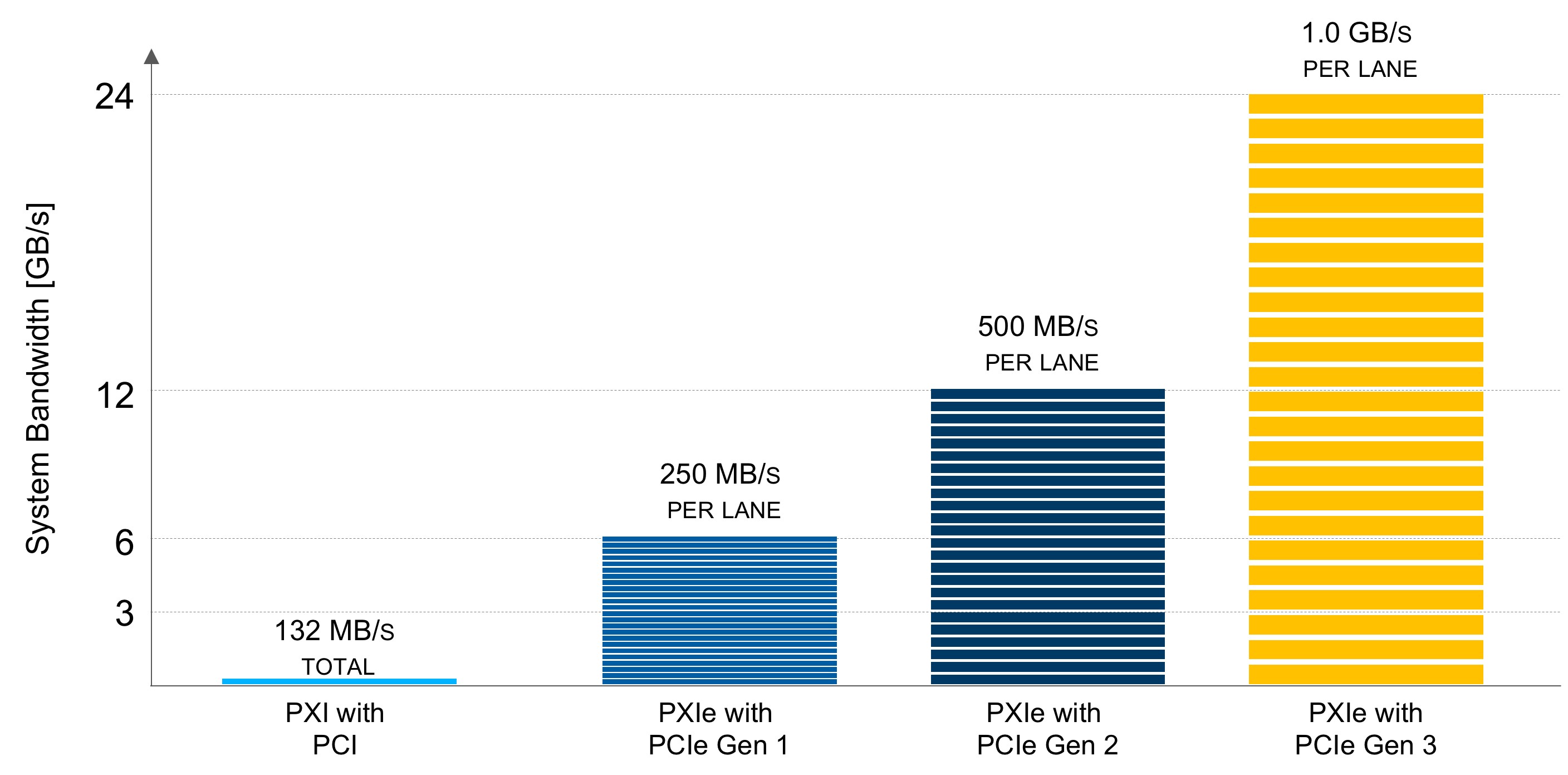PXI Platform Power and Cooling
Overview
Contents
- NI PXI Express Slot Cooling Capacity: 38 W, 58 W, or 82 W
- Featured Chassis with 82 W Slot Cooling Capacity: PXIe-1095
- Next Steps
NI PXI Express Slot Cooling Capacity: 38 W, 58 W, or 82 W
The PXI Express specification requires that a minimum of 30 W of power be available to each peripheral slot and that each slot be able to dissipate that same amount of heat. Chassis designed by NI have exceeded these requirements historically by providing 38 W of power and cooling in every slot. Today, some NI chassis can dissipate and cool more than 38 W in either some or all peripheral slots to support new PXI modules that either require additional cooling to function or recommend additional cooling to achieve full capability. These chassis vary in total power, plus total chassis power differs from total available power to the system controller and peripheral modules due to typical chassis overhead, so system power budgeting is always recommended.
Table 1. NI PXI Express chassis with a slot cooling capacity greater than 38 W
| Chassis | Total Slots | Slot Cooling Capacity | Total Power | Operating Environment | |
|---|---|---|---|---|---|
PXIe-1095 |
18 |
82 W |
2400 W* | All modules require ≤ 58 W cooling capacity per slot | 0 - 55 °C |
| Any module requires > 58 W cooling capacity per slot | 0 - 40 °C | ||||
PXIe-1092 |
10** |
82 W |
1200 W | All modules require ≤ 58 W cooling capacity per slot | 0 - 55 °C |
| Any module requires > 58 W cooling capacity per slot | 0 - 40 °C | ||||
PXIe-1084
|
18
|
58 W
|
800 W
| All modules require ≤ 38 W cooling capacity per slot | 0 - 50 °C |
| Any module requires > 38 W cooling capacity per slot | 0 - 40 °C | ||||
PXIe-1088
|
9
|
58 W
|
400 W
| All modules require ≤ 38 W cooling capacity per slot | 0 - 50 °C |
| Any module requires > 38 W cooling capacity per slot | 0 - 40 °C | ||||
* The PXIe-1095 offers two hot-swappable power supplies. To dissipate 82 W of power in every slot, both power supplies are required. For applications consisting entirely of modules dissipating up to 38 W each, only one power supply is required – a second power supply is redundant to such applications.
** The PXIe-1092 includes an additional peripheral expansion slot in Slot 10, which does not have a PXI Express connection but can provide power for multi-slot modules. See the user manual for more details.
Implications for PXI Modules
Some new PXI modules either require additional cooling to function or recommend additional cooling to achieve full capability.
82 W Slot Cooling Capacity Required
Some high-performance PXI modules require the use of a chassis with 82 W slot cooling capacity to function.
Table 2. PXI modules requiring a chassis with 82 W slot cooling capacity - see the device specifications for more details
| Modules | Rationale |
|---|---|
PXI Digital Pattern Instruments
|
|
≥ 58 W Slot Cooling Capacity Required
Some high-performance PXI modules require the use of a chassis with ≥ 58 W slot cooling capacity to function.
Table 3. PXI modules requiring a chassis with 58 W slot cooling capacity - see the device specifications for more details
| Modules | Rationale |
|---|---|
|
|
|
|
| |
|
≥ 58 W Slot Cooling Capacity Recommended
For several PXI modules, NI recommends the use of a chassis with ≥ 58 W slot cooling capacity to achieve full capability. In general, increased cooling will benefit all existing PXI modules by reducing the temperature of onboard components, helping to prolong device longevity.
Table 4. To achieve full capability with these PXI modules, NI recommends a chassis with ≥ 58 W slot cooling capacity - see the device specifications document for more details
| Modules | Benefits |
|---|---|
|
|
|
|
|
|
Featured Chassis with 82 W Slot Cooling Capacity: PXIe-1095
The PXIe-1095 chassis offers 82 W of power and cooling in every slot, more than double that of previous NI PXI Express chassis. This specification is valid for a chassis filled with modules each requiring 82 W of power dissipation. More power and cooling in every slot allows higher power budgets for PXI modules and makes it possible for the PXI platform to continually serve challenging, high-performance applications.
In addition to 82 W of power and cooling in every slot, the 18-slot chassis offers several other key features like a second, quieter 38 W cooling profile, two hot-swappable power supplies, an optional timing and synchronization upgrade, and up to 24 GB/s PCI Express Gen 3 theoretical system bandwidth.
Two Cooling Profiles: 38 W and 58 W / 82W
The PXIe-1095 offers two distinct, software-selectable cooling profiles: 38 W and 58 W / 82 W. The lower cooling profile tunes the fan algorithm to cool a chassis full of modules each requiring up to 38 W of power dissipation, and the higher cooling profile increases the fan speeds to cool a chassis full of modules each requiring up to 58 W or even 82 W of power dissipation. All modes set are persistent across system reboots. The chassis may increase its fan setting from Auto to High or from the 38 W profile to the 58 W / 82 W profile based on requests from certain modules.
Figure 1. Choose an appropriate cooling profile within Measurement and Automation Explorer (NI MAX)
Reduced Fan Noise
The PXIe-1095’s lower 38 W cooling profile features a significant reduction in fan noise, delivering a 13 dB improvement compared to the previously released PXIe-1085 chassis and making it one of NI’s quietest PXI Express chassis in this mode. The PXIe-1084 has even further improved acoustics in its 38 W cooling mode. You can take advantage of the improved acoustics in the 38 W cooling profile mode with any previously released PXI Express or PXI hybrid modules. Note that 10 dB here translates to a perceived noise difference of 2X.
Table 5. Compare the sound pressure level of PXI Express chassis.
| Fan Speed | Sound Pressure Level [dBA]* | ||||
|---|---|---|---|---|---|
| PXIe-1084** | PXIe-1095** | PXIe-1062Q | PXIe-1075 | PXIe-1085 |
Auto fan (up to 30 °C) | 34.4 | 37.7 | 43.6 | 45 | 51.2 |
High fan | 55 | 56.6 | 62 | 63.3 | 64.1 |
* Sound pressure level is defined at operator position in accordance with ISO 7779
** 38 W cooling profile mode only; higher cooling profiles have a higher sound pressure level
Two Hot-Swappable Power Supplies
The chassis offers two hot-swappable, highly serviceable 1,200 W power supplies. To dissipate 82 W of power in every slot, both power supplies are required. For applications consisting entirely of modules dissipating up to 38 W each, only one power supply is required—a second power supply is redundant to such applications.
Figure 2. The PXIe-1095 offers two hot-swappable 1,200 W power supplies
Timing and Synchronization Upgrade
With the PXIe-1095, a new option is the ability to add a timing and synchronization upgrade at time of purchase. The upgrade includes an integrated oven-controlled crystal oscillator (OCXO) as well as external clock and trigger routing. In this way, you can upgrade your system’s clock stability and accuracy without having to sacrifice the system timing slot. However, this upgrade option is not ideal for every application, because PXI timing and synchronization modules offer several more features that this upgrade option is incapable of, like star triggers, differential star triggers, or others through software like accounting for cable length skew correction in multichassis systems.
Figure 3. The chassis offers an optional timing and synchronization upgrade that includes a built-in OCXO for increased clock accuracy and external clock and trigger routing.
PCI Express Gen 3 System Bandwidth
Like the previously released PXIe-1085, the PXIe-1095 offers 24 lanes of PCI Express Gen 3 technology for a theoretical maximum of 24 GB/s system bandwidth.
Figure 4. System bandwidth for each generation of PXI and PXI Express based on the 24 available data lanes




